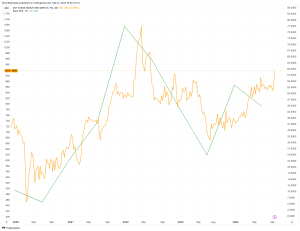As an investor always on the lookout for opportunities in markets such as the FTSE 250, it’s equally important to identify companies that may face significant challenges. After careful analysis, two companies have caught my attention for different reasons: Marks and Spencer (LSE: MKS) and Aston Martin Lagonda (LSE: AML). Here’s why I’m cautious about these companies for the foreseeable future.
Marks and Spencer
Marks and Spencer — or M&S — the British retail giant, has been a surprising success story over the past year, with its shares surging nearly 50%. This performance has significantly outpaced the broader UK stock market (which returned 6.3%).
Despite this impressive run, I feel like there are reasons for caution. According to a discounted cash flow (DCF) analysis, the company is stock trading at about 38.1% below estimated fair value. While this might seem like an opportunity, it’s worth considering why this discount exists.
M&S has shown strong earnings growth, with profits increasing by 49.8% a year over the past five years. However, the retail landscape remains challenging, with ongoing shifts in consumer behaviour and increasing competition from online retailers.
The big concern for me is that shareholders have been diluted in the past year. This has only been by 2.3%, but is often a sign that a company is struggling to generate enough cash flow to fund its operations or growth initiatives.
On the positive side, M&S offers a dividend yield of 1.4% with a conservative payout ratio of 14%, suggesting ample room for future dividend growth.
Aston Martin Lagonda
Turning to the luxury automotive sector, Aston Martin presents a more challenging picture. The shares have plummeted by 58% over the past year.
Based on the same discounted cash flow (DCF) calculation as above, Aston Martin is currently trading at 60.9% below estimated fair value. However, this deep discount reflects significant concerns about the company’s future.
One of the primary issues for Aston Martin is its profitability. The company reported a net loss of £293.20m in the trailing 12 months, with a worrying net profit margin of -18.27%. This indicates that Aston Martin is struggling to convert its revenues into profits.
Debt levels are also concerning, with a debt-to-equity ratio of 130.7%. This high leverage leaves Aston Martin vulnerable to downturns and volatile interest rates, especially when political and economic uncertainty is rife.
On a more positive note, analysts forecast earnings growth of 81.69% a year. If achieved, this could help the company address its profitability issues. However, given the recent performance and the challenges facing the car industry, I feel like these projections should be viewed with caution.
Difficult times ahead
So while Marks and Spencer shows some signs of improvement, I feel like its recent strong performance and ongoing challenges in the retail sector warrant caution. Aston Martin, on the other hand, faces significant financial and operational hurdles that make it a high-risk investment at this time. With so many opportunities across the stock market, I suggest that there are far more lucrative, and less risky, investments out there. I won’t be investing for now.
This post was originally published on Motley Fool







